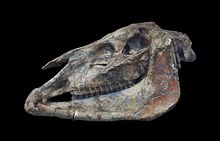Hippotherium
Appearance
| Hippotherium Temporal range: Middle to Late Miocene
| |
|---|---|

| |
| Skeleton of Hippotherium primigenium, Staatliches Museum für Naturkunde Stuttgart | |
| Scientific classification | |
| Domain: | Eukaryota |
| Kingdom: | Animalia |
| Phylum: | Chordata |
| Class: | Mammalia |
| Order: | Perissodactyla |
| Family: | Equidae |
| Subfamily: | Equinae |
| Tribe: | †Hipparionini |
| Genus: | †Hippotherium Kaup, 1832 |
| Species | |
| |
Hippotherium is an extinct genus of horse that lived in during the Miocene through Pliocene ~13.65—3.3 Mya, existing for 10.35 million years.
Morphology
One specimen was estimated to have weighed 61.5 kg (140 lb) in life.[1]
Species





The type species, H. primigenius, is known from Miocene deposits in Europe and the Middle East, while the species H. koenigswaldi and H. catalaunicum have been found in found in Miocene deposits in Spain. The Asian hipparionin "Hipparion" weihoense from early Late Miocene deposits in northern China was referred to the genus by Bernor et al. (2018).[2]
Fossil distribution
- Doue-la-Fontaine France estimated age: ~13.65—7.25 Mya.
- Lower Bakhtiari Formation, northern Iraq, estimated age: ~11.6—9.0 Mya.
- Kurtchuk-Tchekmedje, Turkey estimated age: ~11.61—5.33 Mya.
References
- ^ M. Mendoza, C. M. Janis, and P. Palmqvist. 2006. Estimating the body mass of extinct ungulates: a study on the use of multiple regression. Journal of Zoology 270(1):90-101
- ^ Raymond L. Bernor; Shiqi Wang; Yan Liu; Yu Chen; Boyang Sun (2018). "Shanxihippus dermatorhinus comb. nov. with comparisons to old world hipparions with specialized nasal apparati". Rivista Italiana di Paleontologia e Stratigrafia. 124 (2): 361–386. doi:10.13130/2039-4942/10202.
